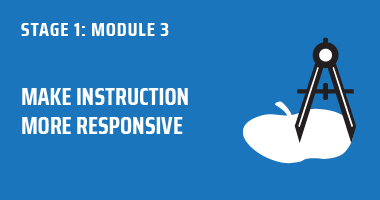Lesson 1- Helping Students Make Content Relevant
MAKE INSTRUCTION MORE RESPONSIVE
TIMING/TASKS: Video Length 50 minutes. To complete this lesson: 1) Watch video to end; 2) Read additional text below; 3) Download & complete exercise(s) in right column
Wax On, Wax Off
OUTCOMES
LESSONS IN THIS MODULE
DOWNLOADS / RESOURCES
RESOURCES
EXERCISES
I will be able to introduce 1-2 cognitive tools for getting students to make the content relevant
I will be able to scaffold a gradual release of responsibility to the point that my most vulnerable students are regularly using their cognitive tools
I will be able to get students to become observers of their learning moves with a new level of attention
Getting students ready for rigor requires that you help each student become aware of her learning moves. Regardless of the subject you teach or the grade level, there is a set of cognitive tools that students need to develop over time to level up their learning power. This is the key to interrupting the invisible forces of inequity by design aimed at under-developing the cognitive capacity of diverse students.
As we go into this lesson, we want to focus on giving students this set of tools and providing opportunities to practice using them in low-stakes situations.
Helping students make content relevant is your first step in moving toward becoming more culturally responsive. That’s the upside. The challenge is you will be moving deeper into the dip of conscious incompetence: recognizing the knowing-doing gap.
It is going to be very tempting to say, “Oh, I already do that,” and move on in search of a new shiny strategy that seems “culturally responsive” because it has some element of multiculturalism or social justice in it. Remember, Inequity by Design wants you to be distracted by shiny strategy syndrome! It’s counting on it. You have to have the discipline to resist.
Instead, we want to focus on not what YOU do but what the STUDENT can do. As the personal trainer of your students’ cognitive development, your job is to provide them with new cognitive tools, not just engage them in random activities, employ the latest fad strategy, or do interesting project-based units.
This is the first piece of your “instructional starter kit”: building your capacity to help students make content “sticky” and comprehensible. That’s all that “relevance” means.
Focus on selecting a set of cognitive tools and giving them to students over the course of the next 4-5 weeks to practice until they routinely use them without little prompting.
ACTION ITEMS
Create an integration plan for introducing the cognitive tool to students
Provide students with opportunities to use and own the cognitive tool
Save to My Content

